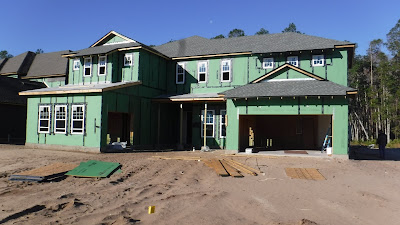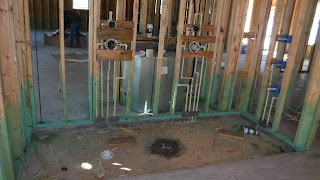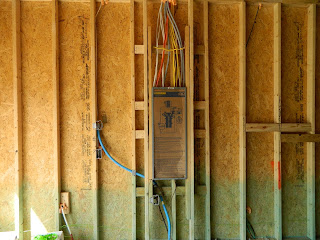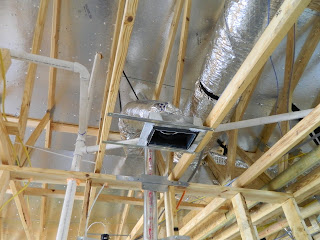CRAWLSPACES IN NORTHEAST FLORIDA
Crawlspaces in the Jacksonville area are normal in homes
built prior to the 1960’s. The
Jacksonville area is a pretty unique community with planned streets and lots
with good draining yards to neighborhoods where the lots are poorly draining
resulting in damp to wet crawlspaces and the resulting issues.
CRAWLSPACE FOUNDATION TYPES
Vented (traditional) crawl
space: a crawl space with a continuous perimeter foundation wall
(typically masonry) with ventilation openings to the outdoors intended to
control crawlspace humidity. This is a typical foundation type we will normally
see in our area.
Open crawlspace: a crawlspace where individual piers
(typically wood, masonry, or concrete) at the building perimeter support beams
and floor joists. This type of foundation is usually found in homes that pre-date
the 1930’s.
Unvented (sealed,
closed, or conditioned) crawlspace: a crawlspace with a continuous perimeter foundation
wall that is sealed (no wall vents) to improve energy and moisture performance.
Insulation is installed on foundation walls or in floors above. Humidity is
controlled by a dehumidifier, exhaust venting, or HVAC system. Relatively rare
in our area but can be found in newer construction and on homes that have had
past moisture issues.
A crawlspace beneath your home should be a dry and clean
space. Moisture in a crawlspace creates
a multitude of issues that can be difficult and expensive to cure. Let’s look
at causes to poor crawlspace conditions.
In older homes the crawlspace soil elevation maybe lower
that the finished grade of the yard. This can allow roof rain water runoff to
directly enter the crawlspace. This
water then needs to evaporate or percolate into the ground.
In some cases, the lot is so flat the rainwater runoff
has no place to go and the yard and crawlspace remains damp, mucky and even wet
for long periods after a steady rain.
Whenever you have a damp to wet crawlspace the
accumulated moisture has to go somewhere.
This moisture will be driven from warm to cooler/drier spaces as it
evaporates (moisture vapor will rise through the house).
Have you ever walked into an older house and observed a
musty/musky/earth odor? Are the wooden
floors cupping? Is there powdery mildew in the corners near the ceiling on
outside walls and inside closets? If yes, we probably have a wet crawlspace.
1. Floors
above vented and open crawl spaces in hot-humid climates are susceptible to
moisture accumulation that could lead to mold, mildew, and decay within the
floor assembly.
2. Water
vapor generally migrates from areas of higher temperature and relative humidity
to areas of lower temperature and relative humidity (vapor drive). In a humid
climate, during the cooling season, the vapor drive is from the crawlspace to
the relatively cool and dry indoors through the floor assembly.
3. A
vapor impermeable floor covering can trap moisture in the wood subfloor
Conditions within the crawl space can lead to condensation and high wood
moisture content. We call this a
microclimate and it can lead to devastating results in the crawlspace.
MOISTURE MOVES FOR MANY
REASONS
Moisture migration: water
can enter the crawlspace as liquid (rain or groundwater) or water vapor. Water
vapor can migrate from the crawlspace into the house due to air leakage and
diffusion.
Water vapor migration due to
air leakage: the transport of water vapor carried within moving air
through air leaks in the floor assembly. Can be controlled with effective air
barriers and air sealing.
Water vapor migration due to
vapor diffusion: the migration of water vapor through permeable
building materials. Can be managed using vapor retarders.
Vapor permeance: a
measure of the rate of water vapor diffusion through materials. A lower “perm”
rating indicates the material is less vapor permeable.
Relative humidity (RH): the
amount of water vapor in air relative to the maximum amount air can hold at the
same temperature. RH increases if air gets colder without losing moisture
because warm air can hold more moisture than cold air.
Dew Point (DP): the temperature at which water vapor
condenses into a liquid on surfaces (100% RH).
Moisture content
(MC): the weight of
moisture contained in wood expressed as a percentage of the wood’s dry weight. The end
result is that moisture must be controlled in our buildings. Left unchecked
moisture migration can lead to wood decay and fungi in the structural framings,
wood subflooring, and high indoor relative humidity resulting in our cooling
system working extra hard to lower the humidity and temperature in the summer
and excessive condensation on cold surfaces in the winter months.
WHAT ARE THE SOLUTIONS
We recommend
that our clients take a systematic approach to problem solving.
- Install the largest gutter you can
afford, but certainly nothing less than 5” and best would be, 6”K style gutters
with sufficient downspouts to move water away from the foundation edge.
- Ensure the home has a at least a 1-2%
slope away from the foundation walls. This will ensure that you have positive
drainage away from the home.
- If the home has soils in the
crawlspace that is lower than finished grade you may need to install vent or
window wells. These are manufactured assemblies that let air in but keep water
out
- Install a good quality vapor barrier
over 90% of the crawlspace. Tape all overlaps in the plastic barrier.
- Seal all holes through the floor
system (plumbing and electrical penetrations).
- Low flat lots may need specialist to
determine low spots in the crawlspace to regrade and install sump pumps to
mechanically extract and move water to the curb.
- Perimeter drains and mechanical pumps
may be required if the lower cost solutions above will or don’t work.
- Finally, the most expensive method is
call a sealed crawlspace. This is an expensive process where the crawlspace is
sealed from the exterior. This involves the use of open and or closed cell
foams, ridged insulation, heavy duty vapor barriers, and de-humidification. It
may also require re-grading the crawlspace and installation of sump pumps in
low areas to extract water from beneath the vapor barrier or if surface
moisture is detected.
SOME THINGS TO DO AND NOT DO
Do keep your
crawlspace dry and clean.
Do keep you
gutters clear of debris and extended away from foundation walls.
Do keep your
crawlspace well vented (if a vented crawlspace).
Do keep your
access cover closed (keeps out those stray cats and other critters).
Do install a
vapor barrier over at least 90% of the exposed soils.
Do maintain
a positive 1-2% slope at exterior walls.
Do an annual
inspection of your crawlspace (look for termites and moisture issues).
Do install foundation
well vents if soils in crawlspace are lower than finished grade.
Don’t place
heating and cooling ducting in crawlspace unless it is absolutely dry year
round.
Don’t insulate
your crawlspace unless it is absolutely dry year round.
Don’t install
porcelain tiles or other non-permeable floor finishes in the home.
Don’t allow
soils to wood contact (keeps those termites out).
Don’t do
interior improvements until you have corrected all crawlspace deficiencies.





















